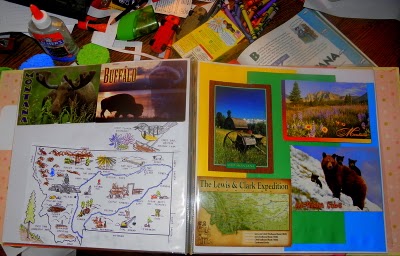Lewis and Clark and The Corps of Discovery, part 2 From Fort Mandan to the Rocky Mountains
Lewis and Clark and the Corps of Discovery, part 1: From St. Louis to Fort Mandan
In April of 1805, the Corps of Discovery was ready to leave Fort Mandan and begin the second part of their journey. They sent their Keelboat back to St. Louis with a small party of men, their journals and a map of what they had experienced so far, along with animal specimens. That winter at Fort Mandan they had made six dugout canoes and so the rest of the Corps continued up the Missouri in two pirogues and the canoes.
In April of 1805, the Corps of Discovery was ready to leave Fort Mandan and begin the second part of their journey. They sent their Keelboat back to St. Louis with a small party of men, their journals and a map of what they had experienced so far, along with animal specimens. That winter at Fort Mandan they had made six dugout canoes and so the rest of the Corps continued up the Missouri in two pirogues and the canoes.
 |
| photo source: Going Along with Lewis and Clark by Barbara Fifer |
Along the way, Lewis and Clark collected many plant samples and pressed them in a plant press to keep them. We decided to make our own simple plant presses to take along on our nature walks.
These are simple to make and lightweight to carry.
 |
| All the materials you need to make a simple plant press. |
All you need for these presses is two pieces of cardboard the same size and some copy paper cut or folded to be the same size as the cardboard. Layer the cardboard on the outside of the sandwich and the copy paper is folded inside. Rubber-bands keep the press together and tight so that the plants will press.
The boys have mainly been pressing the four and five leaf clovers they have been finding.
They also added some leaf rubbings and...
some sketches of plants to their journals, just like Lewis and Clark.
This is a wonderful resource for seeing just what plants they saw and collected.
There are many exciting stories told by Lewis and Clark and their men about their adventures. For example, they were not used to the Grizzly bear and were impressed by its strength, fortitude and speed. On one encounter with a Grizzly bear, the had to shoot him eight times before he was killed.
 |
| student leaf rubbings |
 |
| student watercolor sketches |
This is a wonderful resource for seeing just what plants they saw and collected.
 |
| student narrative sketch of Lewis and Clark meeting the Grizzly bear |
Another incident involves the interpreter Charbonneau who was hired by the expedition. He and his wife, Sacajawea are in one of the pirogues and a sudden squall comes up. Charbonneau, not an experienced sailor, doesn't know what to do and begins shouting for God's mercy. The pirogue fills with water and important articles such as the journals, maps and instruments begin floating away! Cuzatte, another member of the Corps, begins shouting directions to Charbonneau and Sacajawea begins collecting the items floating away. The pirogue was finally taken under control and Sacajawea had saved most of the items.
 |
| our salt map of the US |
The Corps then finally comes to the Great Falls and discovers that it is not just one waterfall but a series of five falls and it turns out that it takes 18 miles of portage to go around them. They make two wagons with wheels made of slices of cottonwood trees. The white pirogue's mast was cut in two for axle rods Prickly Pear cactus was a major problem during their walk because they went through the men's moccasins.
 |
| student sketch of Sacajawea |
We also enjoyed looking back over the states that the Corps went through in our Postcard-Geography Album.
Montana
Oregon
North Dakota
South Dakota






